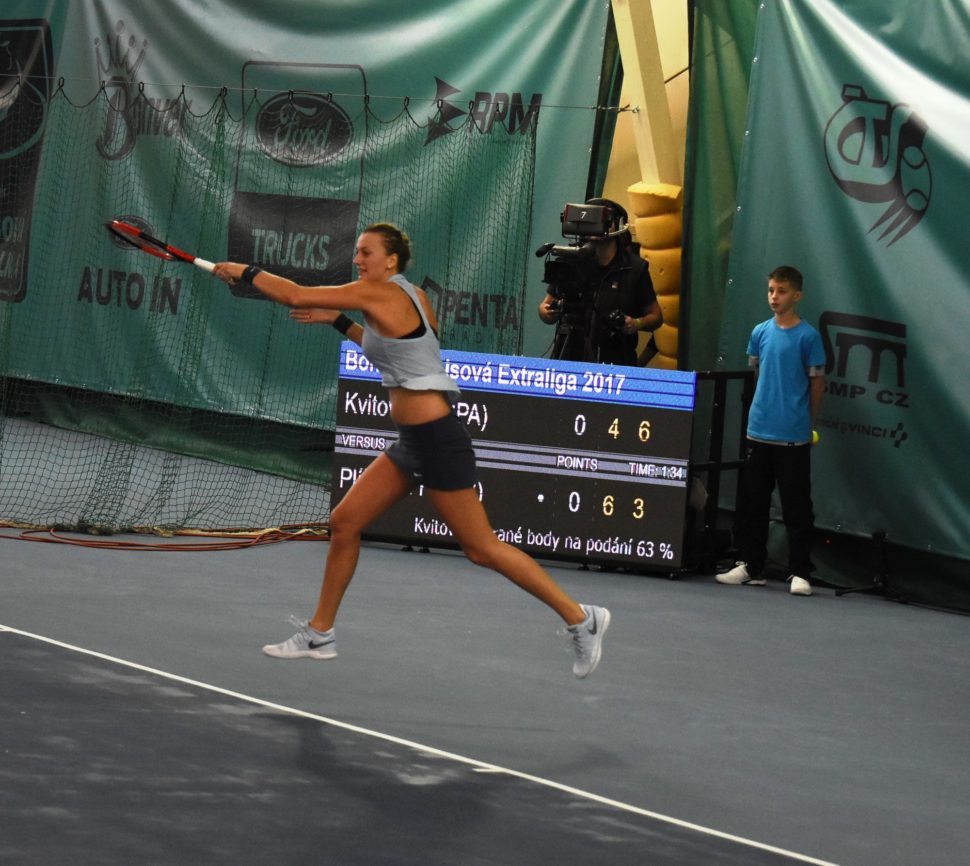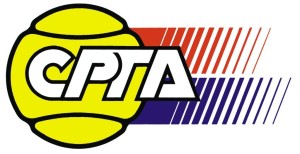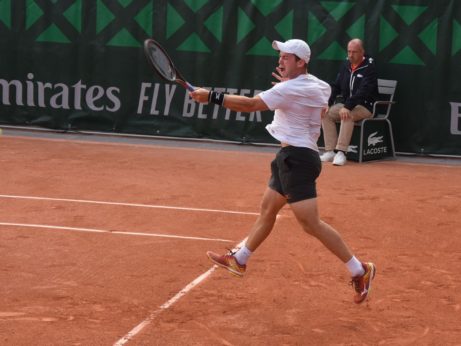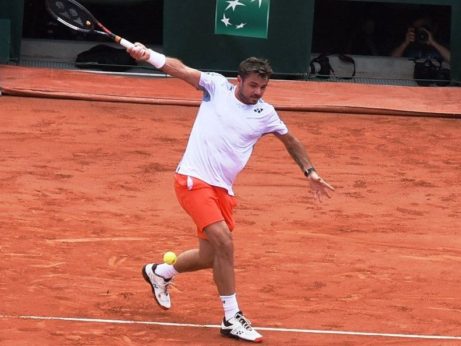Petra Kvitova – Forehand improvement to a higher 3.0 standard

The 6′ (=182 cm) tall left-handed Czech tennis star, former world #2 Petra Kvitova (*1990 / CZE), Wimbledon Singles Champion on two occasions (2011 & 2014) as well as 5-times Fed Cup winner with the Czech team, seems to be coming, after a tragic knife injury to her hitting hand occurred during an apparent burglary in her Prostejov (CZE) home at the end of 2016, to an excellent form again. Throughout her recent winning campaign at the 2018 Ladies’ Trophy in Sankt Petersburg (RUS), where she won her 21st career tour title, Petra sometimes seemed to be almost unbeatable. And thereafter, she was able to carry on with the peak performance, in her two winning FedCup singles matches of the tie Czech Republic against Switzerland in Prague as well as during the Premier 5 Qatar Open in Doha, where she captured her 22nd title already. In the course of these 3 events, which brought her 13 consecutive wins, besides mostly strong serving and the traditionally very good backhand, Petra has shown quite a big improvement in her forehand, which has been rather a bit the troubled stroke throughout her entire career on the tour.
Then over the years, the forehand has brought Petra some winners, but often also rather a quite serious amount of errors as some of the Forehand 3.0 principles have been often missing in her game. It was the reason why I have repeatedly criticized her forehand, (also) here on this site, in the past and why I have mentioned some hints towards possible improvements, also to Petra’s surrounding, mainly since the later part of the 2015 season. It might be just a pure coincidence, but especially after the 1st CPTA’s seminar “TENNIS 3.0 – Future of the Game” in Prague (CZE) this past fall of 2017, Petra has started to even better incorporate some of the there introduced and explained “Tennis 3.0 Code” elements into the forehand as well as into the forehand return in the end of 2017. The improvement process was, in my personal opinion, quite well visible in Petra’s matches during the top tier Czech team tennis competition “Extraliga” in the late December 2017 already. In the last few years, this event has developed into a fine-tuning opportunity for the top Czech players after their off-season preparation work and before the restart of the tours in Australia/Asia. The main difference to before, from my point of view, is in the now often longer elbow motion (in a slight helix form) away from the body against the target, which is making more dominant body energy unloading into the stroke possible or better said, is the sign of this process happening. Such process stabilizes both the racket speed as well as the racket position in space.
Petra’s forehand is then one of the good opportunities how to explain the typical technical compromises under the pressure of the competitive tennis. For quite long years, the main focus of the big part of the coaching world was either at the details in the technique – details in the form of the backswing, stances, etc. or at the possibly high racket head speed, regardless of its source. From my personal point of view, what really matters, mainly under pressure, is the ability of the player to unload the body energy into the stroke during the impact as efficiently and as controlled as possible. How successful this was can be best said while observing (besides the stroke outcome) some of the key reference points of the stroke and their interaction aka Tennis 3.0 Code during and shortly after the impact. The combination of the hip, shoulder, elbow and racket positions in the moment of and shortly after the impact (=follow through 1) is what really matters and what is the best indicator of the quality of the stroke played. Saying this doesn’t mean that the preparatory segments of the strokes (form and details of the take-back, stance, etc.) would not matter, but first, these can be slightly individually different and second, under the time pressure, there can be huge situational differences (based on the situational adjustments) in almost all the segments of the strokes (take-back, stance, even grip) all the way to the impact. The very best players then also understand that compromises must be often made in order to achieve a stable impact position in the front of the body and that the energy imparting on the ball during the impact is what really matters. The next aspect coming into the equation is the effort to keep a rather offensive hitting position in the relation to the baseline. With this said, it is surely very important to focus throughout the entire player development on the form/shape of the stroke (technique) in its preparatory segments, this focus, however, should be not self-serving, but much rather outcome-oriented – hitting position in the court, impact in the front of the body, the source of the energy moving the racket and a good racket control/regulation are the aspects that matter most.
While going by the principles of the “3 Step Tennis Stroke Regulation”, which is an approach very typical for the very best players (in many cases to a degree subconscious), the first focus (=1st regulation) of the top players is at the creation of a sufficient space in order to achieve the main goal, using the rotational body energy (=unloading the energy stored during the loading part of the stroke) to freely move the elbow and thus the racket quite far from the body core against the target (=2nd regulation) whenever possible. The players who don’t have this element “hard-wired” in their system to such a degree and who have been developed under the ill-conceived philosophy that the racket head speed is everything, then tend to partly neglect the 1st regulation as they are, from the preparatory stage of the stroke on, focusing on the development of the racket head speed mainly from the elbow/forearm action (flexion), which is a completely different way of the 2nd regulation (focusing at the elbow flexion instead of the elbow position in the space). Such approach then significantly limits the amount of the body energy unloaded upon the racket and it limits also the optimal racket/stroke control through the fine automatic adjustments and proprioception (= 3rd regulation = moderation), which is difficult to be achieved at a high level when the forearm muscles are engaged in the powerful flexion activity. In order to achieve the TENNIS 3.0 standard of a stroke, the unloaded body energy should be the dominating force moving and stabilizing the racket through the impact and the interference from the elbow flexion should be minimal to none. This matters the more the more pressure is being applied by the opponent.
The players across the rankings have a different degree of the TENNIS 3.0 fulfillment from stroke to stroke, based on the circumstances, mainly pressure from the opponent and also on the pre-set ideal stroke image in their mind. In general, the higher the degree of the TENNIS 3.0 fulfillment (= more body energy dominance and less elbow flexion interference) the better potential of the stroke (besides some trick and extreme troubleshooting strokes). The best players then tend to have a higher degree of TENNIS 3.0 fulfillment in a higher percentage of the strokes during a match. The very best tennis players have mostly better anticipation leading to a faster footwork and resulting in a better 1st regulation (=space creation), which is making the optimal body energy unloading possible. This process is also being supported by the “hard-wired” (subconscious) ideal stroke image incorporating the use of the body energy in the strokes. In contrary, players who have learned (developed such ideal stroke image in their mind) to use the elbow flexion as the acceptable or even desired striking activity, tend to have a rather lower degree of the TENNIS 3.0 fulfillment and a lower percentage of the strokes, which can be considered as of the TENNIS 3.0 category, mainly under pressure.
Below, I am comparing photos of Petra’s forehand over the years to document the positive changes in the body energy dominance of this her stroke, which seems to have achieved the highest ever relative TENNIS 3.0 standard in the past weeks. Needless to say, the apparent improvements in the footwork and general fitness were surely also a positive factor making the forehand improvement possible and the higher forehand reliability on the other side certainly added to Petra’s mental and emotional stability during her recent matches.

Petra Kvitova (*1990 / CZE) – Forehand open stance (outside leg push-off) in a practice – 1 of 1 – follow through 1 – the summary of the essential Tennis 3.0 Code reference points (parameters) gives the result that this stroke was dominated more by the arm striking than by the body energy unloading – helix form is not present – 2014 US.Open – New York / USA – August 2014

Petra Kvitova (*1990 / CZE) – Forehand open stance in a practice – 1 of 1 – end of the follow through 1 aka targeted pronation – typical stroke with the arm striking dominance and limited body energy unloading – 2014 US.Open – New York / USA – August 2014

Petra Kvitova (*1990 / CZE) – Forehand open stance in a practice – 1 of 3 – impact – good eye control of the impact zone – 2014 US.Open – New York / USA – August 2014

Petra Kvitova (*1990 / CZE) – Forehand open stance in a practice – 2 of 3 – end of follow through 1 – this stroke has a bit higher body energy dominance (=higher Forehand 3.0 fulfillment) than the strokes shown above – 2014 US.Open – New York / USA – August 2014

Petra Kvitova (*1990 / CZE) – Forehand open stance in a practice – 3 of 3 – follow through 2 = relaxation, balance transfer – 2014 US.Open – New York / USA – August 2014

Petra Kvitova (*1990 / CZE) – Forehand open stance in a match – 1 of 4 – take-back / loading – good pointing with the non-dominant (=right) hand – 2016 US.Open – New York / USA – August 2016

Petra Kvitova (*1990 / CZE) – Forehand open stance in a match – 2 of 4 – acceleration against the ball – despite almost perfect preparation, Petra pulls feet together, reduces the body core rotation and thus strongly limits the body energy dominance of this stroke – 2016 US.Open – New York / USA – August 2016

Petra Kvitova (*1990 / CZE) – Forehand open stance in a match – 3 of 4 – follow through 1 – stroke is dominated rather by the elbow activity, body energy unloading is strongly limited, helix form is not present – 2016 US.Open – New York / USA – August 2016

Petra Kvitova (*1990 / CZE) – Forehand open stance in a match – 4 of 4 – follow through 2 = relaxation – body energy didn’t dominate the stroke and the position of the racket in the space – 2016 US.Open – New York / USA – August 2016

Petra Kvitova (*1990 / CZE) – Forehand 3.o in a match – 1 of 6 – initial pivot and outside (=left) leg positioning – 2017 Czech Tennis Extraliga Finals – Ricany / Czech Republic – December 2017

Petra Kvitova (*1990 / CZE) – Forehand 3.0 in a match – 2 of 6 – take-back – 2017 Czech Tennis Extraliga Finals – Ricany / Czech Republic – December 2017

Petra Kvitova (*1990 / CZE) – Forehand 3.0 in a match – 3 of 6 – loading – perfect pointing with the non-dominant (=right) hand – 2017 Czech Tennis Extraliga Finals – Ricany / Czech Republic – December 2017

Petra Kvitova (*1990 / CZE) – Forehand 3.0 in a match – 4 of 6 – acceleration against the ball /impact – body energy dominates the action – 2017 Czech Tennis Extraliga Finals – Ricany / Czech Republic – December 2017

Petra Kvitova (*1990 / CZE) – Forehand 3.0 in a match – 5 of 6 – follow through 1 – body energy still largely dominates the racket position – the outside (left) hip position in the front is an important indicator – 2017 Czech Tennis Extraliga Finals – Ricany / Czech Republic – December 2017

Petra Kvitova (*1990 / CZE) – Forehand 3.0 in a match – 6 of 6 – follow through 2 = relaxation / balance transfer – 2017 Czech Tennis Extraliga Finals – Ricany / Czech Republic – December 2017

Petra Kvitova (*1990 / CZE) – Forehand 3.0 in a match – 1 of 4 – initial pivot / outside (left) leg mobilisation – 2017 Czech Tennis Extraliga Finals – Ricany / Czech Republic – December 2017
Petra Kvitova (*1990 / CZE) – Forehand 3.0 in a match – 2 of 4 – acceleration against the ball/impact – body energy dominates the “show” – 2017 Czech Tennis Extraliga Finals – Ricany / Czech Republic – December 2017

Petra Kvitova (*1990 / CZE) – Forehand 3.0 in a match – 3 of 4 – end of follow through 1 = targeted long axis pronation – stroke/racket is dominated by the rotational body energy – “Last 20% ” in the desired helix action – very high degree of the Forehand 3.0 fulfillment – 2017 Czech Tennis Extraliga Finals – Ricany / Czech Republic – December 2017

Petra Kvitova (*1990 / CZE) – Forehand 3.0 in a match – 4 of 4 – follow through 2 = relaxation /balance transfer – 2017 Czech Tennis Extraliga Finals – Ricany / Czech Republic – December 2017
A high degree of the Tennis 3.o fulfillment as documented above then makes points like shown below possible – dominant 1st service 3.0 leads to a weaker return from the opponent, Petra is using this opportunity for a dominant Forehand 3.0 approach stroke and finishes the point off with a well-controlled Backhand Volley 3.0 – all three strokes are dominated by the body energy (high degree of TENNIS 3.0 fulfillment) and such situation gives Petra the chance for a perfect 3rd regulation/moderation of the strokes.
Petra Kvitova (*1990 / CZE) – serving point in a Czech team tennis match against Karolina Pliskova (CZE) – 2017 Czech Tennis Extraliga Finals – Oaza Ricany / Czech Republic – December 2017
This article covers certain aspects of Petra Kvitova’s forehand and forehand in general only! Further photos, more details (inclusive improvement possibilities/ideas) about her forehand and other strokes as well as about the strokes of other players are available upon request at drmgb11(at)gmail.com. Some significant details of this kind, necessary for a peak tennis performance as well as for a sustainable tennis training/development in general, are being discussed also in the seminar “TENNIS 3.0 – Future of the Game”, which is available worldwide upon request – www.tennis30.com / www.tennis30.cz
Photos/video (August 2014 & August 2016 & December 2017) & text (February 2018) copyright by Dr. Martin G. Baroch. Any further publication of either any of the photos/video & and/or texts with the explicit written permission issued by the author/copyright owner only!!




